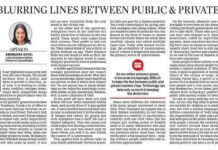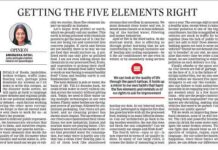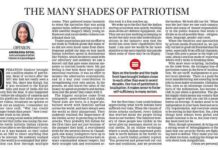This article Airlines and the Art of Complicating Things by Anuradha Goyal, author, and founder of IndiTales.com was first published by the New Indian Express newspaper on October 08, 2021.
Airlines and the Art of Complicating Things
Once upon a time, all I had to do was to buy a flight ticket from a travel agent and reach the airport in time. Everything else was taken care of by the airline staff. Today, with extreme automation, I am not only doing more than half the work of the airline industry. From buying my own ticket to checking in myself, but also dealing with their ever-increasing complication quotient. Devoid of core work of serving the customers, they are busy finding new revenue streams by putting a price tag on everything. In the process, they annoy the customer. Every time there is a popup ad or message to buy add-on services.
48 hours before the flight, my email box, my WhatsApp inbox, and my SMSs are flooded with messages reminding me to check in. They are interspersed with those that push sales for meals, seats, insurance, priority check-in to avoid the queue at the airport. Constant reminders to do so many things assume I have nothing to do but keep reading and acting on the airline’s messages. I am reminded to do free web check-in or pay for the airport check-in. This is after I have checked in and they have forgotten to send me the promised boarding pass. They ask me to print the boarding pass and baggage tag. When my printed baggage tag cannot be put on the baggage, why put pressure on the passenger? How I wish pushing these messages was not so easy and cheap.
Pricing the seat
Every seat now comes with a price tag. If you ask airline algorithms to auto-assign the seat, which as of now is free of cost, they forget to send you a boarding pass. Join the dot that airport check-in comes for a cost. If you point out the glitch in their design, blame can easily be put on technology that remains out of bounds for those questioning. It pains to see that the best seats remain empty and the elderly struggling to make their way to the last rows. Sometimes I wonder if they start by first assigning all the middle seats instead of the other way round. I genuinely want to see the revenue contribution of seat sales for airlines. As it comes at a serious cost of deprioritizing all customer comforts.
Boarding pass
Onboarding pass, tech-savvy travelers beam mobile passes, cautious ones carry printed ones, others print hardly readable ones at the self-check-in counter and a small sample has the good old one – printed by the airline staff. Imagine the confusion this causes while scanning the QR code at multiple checkpoints. At least till the pandemic is around, it would be easier to have a uniform boarding pass that can be easily shown and scanned from a distance. Mobile pass invariably is touched by multiple people. Mobile phone locks multiple times, QR code needs to be in sight and broad daylight blinds the screen.
Pandemic situation
Traveling norms are changing on a daily basis due to the pandemic. Vaccination certificates, RT-PCR reports, symptom checks, and self-declarations have to be accommodated in the flying process. I understand it is an additional step. But now we have been into it for more than a year. Why can’t there be a single Vaccination Flag or code on the boarding pass that ensures no multiple checks are needed at both the boarding and landing airport. The vaccination certificate is linked to my ID. So it should be easy to verify that data. Even if it is not, put a flag on the boarding pass and be done with it.
While on the pandemic, there are so many instructions on wearing masks, maintaining social distance, and other norms. They are followed to an extent. But the moment you have to board the bus taking you to and from the aircraft, all the norms are flouted by stuffing the maximum number of people possible. It would be easier to let people walk to the aircraft. Wonder, why we are not redesigning to let go of the buses that ply for kilometers to cover a small walkable distance.
Buffer time of passengers
Airlines need to seriously work on reducing the buffer time spent before and after the flight. One is expected to reach the airport 2-3 hours in advance. Add 60-90 minutes to reach the airport in big cities. You are asking for 3-4 hours before departure on average. 30 minutes buffer is built into the flight time. It is frustrating to land 30-40 minutes before time when your pickup vehicle has not yet reached the airport, adding another hour at the airport. Not to forget the baggage retrieval time. Buffer time to flight time ratio has to be brought down.
Consumers
We as consumers also need to look at trains as an option for shorter journeys, which may be less glamourous but far easier. Train stations are within the cities. There are no annoying steps, no security checks. No baggage limitations and it stays with you. No sitting in a constrained space. Metaphorically, staying on earth has its own benefits, including being sustainable. For longer ones, hopefully, airlines will make it smoother and comfortable to fly.

Edited for this online publication.








